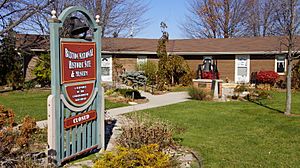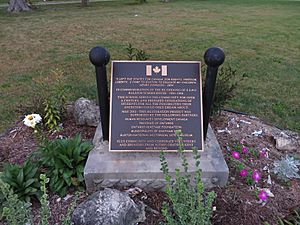Buxton National Historic Site and Museum facts for kids
The Buxton National Historic Site and Museum tells the amazing story of the Elgin Settlement. This special community, also known as the Buxton Mission, was started in 1849. It was a safe place for people who had escaped slavery and for free Black people.
The settlement was founded by Reverend William King. He used to own slaves but later became an abolitionist, meaning he worked to end slavery. He bought a large area of land in Southwestern Ontario. Here, he created a new home for many families seeking freedom. The settlement was also an important stop on the Underground Railroad. This was a secret network that helped enslaved people escape to freedom in Canada.
Contents
A Safe Place: The Elgin Settlement
The Elgin Settlement was carefully planned. It offered 50-acre (200,000 m2) lots of land. Only Black settlers could buy these lots. They had 10 years to pay for their property. This gave them a chance to build a new life. Houses had to meet certain standards, ensuring good quality homes.
Life in the Community
By 1864, the settlement was a thriving community. It had many important buildings and services. There was a steam-powered mill for grinding grain and another for cutting wood. People could buy supplies at two general stores. There were also shops for shoes, blacksmithing, and barrel making.
Education was very important in Buxton. A school taught about forty students on average. The community also had a church where people could gather. This church was quite large, seating up to 200 people.
The End of the Mission
The need for the Buxton Mission changed after the American Civil War. This war ended in 1865. When the war finished, slavery was officially ended in the United States. Because of this, the Buxton Mission Fund was closed. The community had served its purpose as a haven for those escaping slavery.
The Museum Today
Today, the Buxton National Historic Site and Museum keeps this important history alive. The museum first opened its doors in 1967. It helps visitors understand the lives of the people who lived here.
What You Can See
The museum complex has several interesting parts. The main building features exhibits about the community's history. You can also explore an old schoolhouse from 1861. There is an even older log cabin, built in 1854. A barn is also part of the site. Nearby, you can visit historic church cemeteries. The museum is located in North Buxton, Ontario. It was named a National Historic Site of Canada in 1999.
Learn More
- Anna Maria Weems (born around 1840): A brave teenager who escaped slavery and studied at the Buxton Mission School.
- James T. Rapier (1837–1883): He was a student and later a teacher at the Buxton Mission School.
- Uncle Tom's Cabin Historic Site: Another historic site in Ontario that was once a settlement for former slaves.



